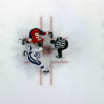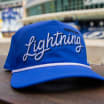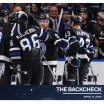Specifically, what are the Lightning doing well defensively? Their puck management has been solid, so they've limited turnovers that could potentially fuel the opposition's attack. When the puck is in the Lightning's offensive zone and the other team gains possession, Lightning forwards are tracking back through the neutral zone. This has not only prevented odd-man rush chances against, it also has given the defensemen the green light to "gap up". Knowing the rush is a three-on-three, the D can step up in the neutral zone and effectively take away time and space from the puck carrier. The other side must then dump the puck in and hope to retrieve it. That's assuming that the Lightning aren't forcing a neutral zone turnover first. In the Tampa Bay d-zone, Lightning players have been structured in their coverage. They're protecting the front of the net, taking away time and space from the attacking team, playing physically, blocking shots, and consistently contesting loose pucks. As far as the PK is concerned, the Lightning are winning faceoffs, clearing pucks when they have a chance, breaking up re-entry attempts, holding their PK structure in the d-zone, blocking shots, and getting key saves from the goaltenders.
With the exception of a couple of isolated segments over the past dozen games, the way they have defended hasn't wavered. But it's interesting to note that, even as they've played solid team D, the Lightning have had games unfold in one of two distinctly different ways.
In the first case - and this has happened in the majority of the last 12 contests - their strong defensive game has led to a lopsided puck possession advantage. Essentially, the Lightning are limiting opposition looks by playing with the puck most of the night. This has been particularly evident during many of the six homes during the stretch. The 2-1 win over Detroit on December 29 and the 4-0 triumph against Arizona on January 9 were extreme examples of this type of "defending". It's hard for the other team to score if it doesn't have the puck. Of course, the fundamentals of good team defense listed above are still in effect. The Lightning are managing the puck well, tracking back through the neutral zone, and playing tightly without the puck in their own end. That's allowing them to get the puck back quickly when they don't have it and maintain possession when they do.
But it's hard to dominate possession every night. What's been happening when the Lightning are ceding possession time for a portion of a game? It's not that they have "gifted" pucks with sloppy turnovers in these moments. Rather, the opposition is executing well and, usually because the other side has been trailing, it is making a push. When these stretches have occurred, they've generally taken place at different points during the Lightning's past six road games. Here are examples from three different recent third periods: at Montreal on January 2, at Carolina on January 5, and at Philadelphia last Saturday. Naturally, it's more ideal to play defense by dominating puck possession. But the Lightning have managed these segments just as well. Even though they've had to spend more in their own end, they're relying on the same bread-and-butter defensive components. They're limiting dangerous turnovers. They're preventing odd-man rush chances. They're protecting the front of the net, so the majority of opposition shots aren't coming from prime scoring locations. They're blocking shots. Boxing out in front of the goalie, so the opposition can't generate rebound looks. And, of course, when there has been the occasional breakdown, the goalies are making key saves. The good news is that those instances of Grade-A chances against have been few and far between.
It's important that the Lightning are navigating their way through both of those types of games. Their strong defensive fundamentals have allowed them to both overwhelm teams and stubbornly dig their heels in to survive a third period opposition surge.



















